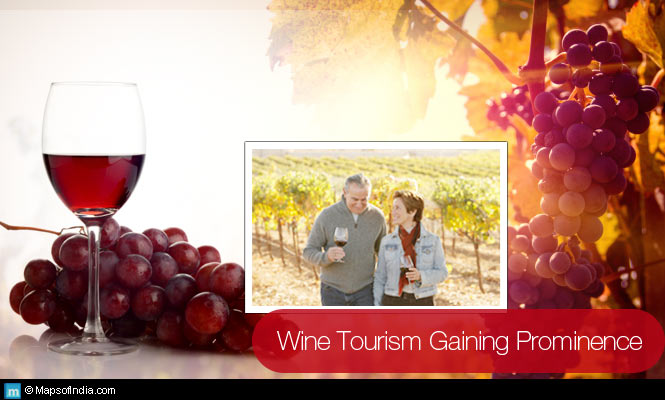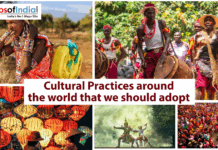 Wine is the child of carefully spoiled grapes. Viticulture is the science of cultivating grapes, especially for wine production. Indians have been practicing viticulture since the Indus Valley Civilisation. During this historically important period, grapevines from Persia were introduced in India. The culture gained impetus in the British Raj. The Indian wine industry, however, suffered in the last quarter of the nineteenth century due to grape phylloxera, a microscopic aphid that feeds on the grape roots. Post-independence anti-alcohol sentiments of public and religious bodies put another spoke into the industry’s wheel. With the birth of the middle-class during 1980-1990s, wine culture reappeared. Slowly the culture gave birth to a new type of tourism, wine tourism, oeno-tourism, eno-tourism, or vini-tourism.
Wine is the child of carefully spoiled grapes. Viticulture is the science of cultivating grapes, especially for wine production. Indians have been practicing viticulture since the Indus Valley Civilisation. During this historically important period, grapevines from Persia were introduced in India. The culture gained impetus in the British Raj. The Indian wine industry, however, suffered in the last quarter of the nineteenth century due to grape phylloxera, a microscopic aphid that feeds on the grape roots. Post-independence anti-alcohol sentiments of public and religious bodies put another spoke into the industry’s wheel. With the birth of the middle-class during 1980-1990s, wine culture reappeared. Slowly the culture gave birth to a new type of tourism, wine tourism, oeno-tourism, eno-tourism, or vini-tourism.
According to Indian Horticulture Database, India produced 24,83,094 metric tons of grapes in 2012-13, just 3.63% grapes of total global production of 6,83,10,223 metric tons. In domestic fruit market, grapes accounted for just 3% of total production. Similarly share of India in international tourist arrivals was just 0.67% in 2013.
In 2001, the Maharashtra Grape Processing Policy drew many new entrepreneur farmers to viticulture. However, making a perfect wine is a demanding process, requiring special skills. A large number of new unskilled players thus failed and incurred substantial debt. The farmers took a decade to learn the art of wine making. In the next stage, focus would be on making quality wine to meet standards defined by the International Organization for Vine and Wine (OIV) to tap export market.
Bengaluru, the adventure and IT capital of India, has quickly adopted wine culture. The grape drink has become a part of weekend meals.
Indian wines are becoming popular because they are cheaper than Italian and French wines.
Top Wine Circuits and Trails
Maharashtra is the leading wine producer (including grape-wine) in India. Nashik, home to the largest number of vineyards, is the hub of fledgling wine industry.
Nashik, the wine capital of India, boasts perfect climate for cultivating grapes and availability of water and land. The district draws many wine tourists daily and may emerge as a big player.
The farmers in Nashik grow both table and wine grapes to cash in on the new trend. More than half of the wineries of Maharashtra are in Nashik. The district has both big and small players. For example, Dindori, a small town, has some of the finest vineyards and wineries managed by Chateau d’Ori and Pause Wines.
York Winery, commanding views of the Gangapur Lake (Nasik), features a theatre-like entertainment room and restaurant. The winery hosts about 400 wine tourists per week.
Until 2006, Baramati was just one of the leading cultivators of table grapes because local climate and soil are perfect for the crop. The year when the region started growing wine grapes, things changed. Four Seasons built its flagship winery in Rotti, Baramati. Today, the Rotti vineyard offers French chateau-style accommodation affording views of the processing unit. The vineyard also organizes winery tours that show complete wine making process and conduct appreciation and tasting sessions. Harvest season is the best time to enjoy a tour of a vineyard. The best time thus to visit Baramati vineyards stretches between January-March. Fratelli Winery in Solapur district also caters to wine tourists.
The second biggest player in wine industry and wine tourism is Karnataka. Badami, for instance, organized wine festival and wine tours to Bijapur and Bagalkot during a three-day Badami Festival in February 2014 to promote wine culture.
The Nandi Hills and the Krishna Valley are home to a number of wineries. Belgaum and Bijapur are two principal wine centres in the valley. The wineries host wine tours regularly to take advantage of the new oeno tourism trends.
Heritage Winery located near Channapatna in Karnataka has been organising wine tours for families since 2011.
The four-day Grape Escapade 2015, the biggest wine festival in India, started on 23 January in Goa. One of the highlights of the festival was grape stomping.
Key Players
Maharashtra, Karnataka, and Telangana are the leading viticulture centres in India. However, Karnataka (8.6%) and Maharashtra (7.2%) ranked fourth and fifth in terms of number of domestic tourist visits in 2013. Maharashtra recorded the highest foreign tourist visits (20.8%). Karnataka with 3.2% of total foreign tourist visits was at ninth place. Together, these numbers look good for setting the foundation for wine tourism.
Sula Vineyards
Sula Vineyards in Maharashtra lead the Indian market. Their competitors include Four Seasons, Grower Zampa Vineyards, and Pernod Ricard.
Sula built restaurants, resorts, tasting rooms, and a boutique bungalow to cash in on the upward trend of wine tourism. The company hosts 2,00,000 visitors every year and organises wine festivals.
Challenges
Grapes can be consumed in three different ways: drunk, eaten, and / or stomped. The first type of consumption faces five major challenges:
- Tourist accommodation in wine areas is inadequate.
- The wine tax policy varies from state to state.
- Per capita Indian wine consumption is just 10 ml.
- Distribution and storage infrastructure is poor.
- The biggest challenge is why spend crores in promoting a bad habit at first place and then after a decade or so try hard to kill it. I think grape tourism or fruit tourism is better than wine tourism. During fruit tours, you can pick fresh fruits from orchards and relish them, a recipe for a healthy holiday. So next time when you go on a vineyard tour, taste fresh and luscious grapes of one of your favorite colours: black, blue, green, purple, and red, instead of sipping bottled version of the fermented fruit. And ensure that the child does not play a spoilsport. The three facts favour the argument:
- Alcohol is not good for mental and physical health.
- Father of Nation Mahatma Gandhi advocated alcohol prohibition for good reasons.
- Health benefits of red wine are hyped. Recent scientific studies did not find any evidence supporting the fact that resveratrol found in red wine prevents heart diseases.





